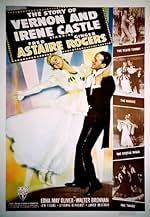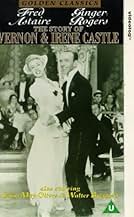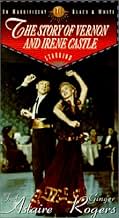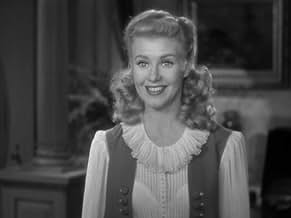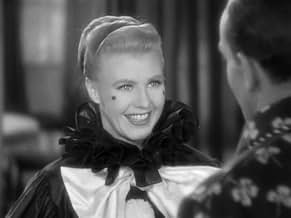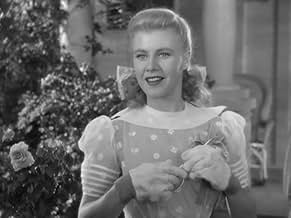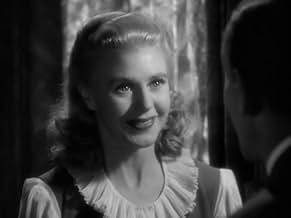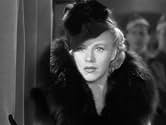L'histoire vraie et tragique d'Irène et Vernon Castle l'un des couples de danseurs les plus connus et respectés du début du XXème siècle, brisé par la mort de l'époux dans son avion, au cour... Tout lireL'histoire vraie et tragique d'Irène et Vernon Castle l'un des couples de danseurs les plus connus et respectés du début du XXème siècle, brisé par la mort de l'époux dans son avion, au cours de la Première Guerre Mondiale.L'histoire vraie et tragique d'Irène et Vernon Castle l'un des couples de danseurs les plus connus et respectés du début du XXème siècle, brisé par la mort de l'époux dans son avion, au cours de la Première Guerre Mondiale.
- Réalisation
- Scénario
- Casting principal
- Récompenses
- 4 victoires et 1 nomination au total
- Undetermined Secondary Role
- (non crédité)
- Waiter - Cafe de Paris
- (non crédité)
Avis à la une
This movie pays glorious tribute to the Castles and their dance repertoire which Astaire and Rogers beautifully replicate. The crazy maze of fame that swirled around the young couple, their great love for each other and their private travail, are sensitively presented. The supporting cast includes the always superb Walter Brennan as the Castles' chaperone-servant, and Edna May Oliver as their agent, a take-off on real-life Elisabeth (Bessy) Marbury. Producer Lew Fields, who gave Vernon Castle his first job on the New York stage, makes a cameo appearance.
Although Irene Castle served as technical advisor and assisted Walter Plunkett with costuming, there were polite clashes on the set (and off) between her and Ginger Rogers who objected, most notably, to Irene's insistence that she dye her hair dark and cut it short to more accurately resemble her. For those familiar with Irene Castle, whose extraordinary looks (particularly the bobbed hair-style she introduced) were so much a part of her image, they will understand Irene's dissatisfaction with long-tressed, blonde Rogers. It says much for Ginger Rogers' capabilities that the story is not hindered by this departure from authenticity (more glaring then than today).
A NOTE ON COSTUMES:
This film gives some idea of Irene's popularity as a fashion trendsetter which was tremendous in the 1910s and 20s. In fact, many of the stunning gowns Ginger Rogers wears are quite faithful adaptations of costumes designed by Lucile (Lady Duff-Gordon) for Irene Castle during her Broadway and silent-movie days. Ginger's dress with the handkerchief hem and huge chiffon sleeves (double-banded in fur) was copied from the original which Irene wore for the premiere of Irving Berlin's "Watch Your Step" in 1914. This original, by Lucile, is now at the Costume Institute of the Metropolitan Museum of Art. A black and white evening gown, a pleated silk day dress, and a striped travelling suit are other Lucile designs reproduced by Plunkett for Rogers in this picture.
In England there were gales of laughter when Irene says "I feel just like a bride again in my wedding dress and my little Dutch cap." In the UK a Dutch cap is a female contraceptive device which I believe is called a "diaphragm" in USA.
Based on two Irene Castle books, this movie has more plot and more drama than the other Fred and Ginger pairings, and if you can accept that it isn't "Flying Down to Rio," "Top Hat," or "Swing Time," you'll enjoy it. Ginger Rogers does a great job as Irene, in the more dramatic of the two roles, proving again what a wonderful actress she was. The dancing was, of course, great. Ginger's gowns were actually copies of Irene's trendsetting gowns. Irene's hairstyle was well-known as well, and she wanted Ginger to dye her hair dark to match her own. But Rogers refused.
Vernon and Irene, during their short pairing, introduced many dances to the public, including the "Castle Walk" and the fox trot.
The movie's ending is a sad one, but I can't agree with another poster than the final visual was trite. I kind of liked it.
Of all the Fred Astaire-Ginger Rogers films, I would guess this gets the least amount of publicity and if that's true, it's a shame.
There are plenty of dance scenes in here. I prefer the tap dancing to ballroom, but that's just my personal tastes. The famous dancing duo are great with any style. I like Walter Brennan, so it's nice to see him in this film and it also was nice to see Edna May Oliver play a nice character, for a change.
The only complaint was the ending was so predictable. You see it coming a mile away. How true this story is, I can't say, but overall it's one of my favorite Astaire-Rogers movies. I am sorry it gets so little attention.
Irene Castle herself was a technical adviser and helped design the gowns that Ginger wore--which, by the way, are very nice, despite Ginger's protestations.
Because this film covers many years and many happenings, it uses montage quite heavily--something that is usually distracting, but in this case it works well.
The dancing documents a variety of styles, some of which were introduced by Vernon and Irene. At the height of their career, they were trendsetters in dance, fashion, culture and taste. Their first dance in the film is an adaptation of minstrel dancing; later dances include the tango and foxtrot. Astaire must have been familiar with all of these styles and probably had used them in his choreography with sister Adele. Still, his choreography in the film is inspired--showing us the essence of each stage in dance evolution.
Ginger is beautiful and she seems to have a freedom in her performance, as if their relationship had advanced to the point of total trust. I only wish this film--and a few of their others--had been shot in color.
Le saviez-vous
- AnecdotesIrene Castle served as a technical advisor on the film. According to Ginger Rogers, Castle disliked every costume she wore and deemed them anachronistic. Due to censorship restrictions, Rogers' costumes evoked late 1930s fashions rather than the more daring styles of Castle's 1910s era. After Rogers refused to bob her hair to portray the hairstyle that Irene had popularized, Castle became more displeased. The studio silenced Castle's protests with an additional payment of $5,000.
- GaffesThe film erroneously depicts the Castles touring with white orchestras. In actuality, Vernon and Irene Castle always toured with a black orchestra; specifically, James Reese Europe's Society Orchestra.
- Citations
Irene Castle: I thought you could be a first dancer, a very beautiful first dancer because you are a beautiful dancer but you're so smug and conceited that you can't see any further than your funny nose!
- ConnexionsFeatured in Fred Astaire: Puttin' on His Top Hat (1980)
- Bandes originalesOnly When You're in My Arms
(1939)
by Con Conrad - Herman Ruby Bert Kalmar
Sung by Fred Astaire (uncredited)
End dance: Fred Astaire (uncredited) and Ginger Rogers (uncredited)
Meilleurs choix
- How long is The Story of Vernon and Irene Castle?Alimenté par Alexa
Détails
- Date de sortie
- Pays d’origine
- Langue
- Aussi connu sous le nom de
- The Story of Vernon and Irene Castle
- Lieux de tournage
- Société de production
- Voir plus de crédits d'entreprise sur IMDbPro
Box-office
- Budget
- 1 196 000 $US (estimé)
- Durée
- 1h 33min(93 min)
- Couleur
- Rapport de forme
- 1.37 : 1

